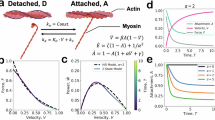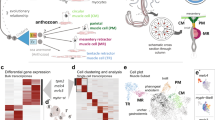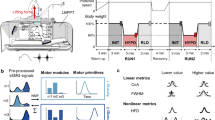Abstract
Muscle is a complex, hierarchically organized, soft contractile engine. To understand the limits on the rate of contraction and muscle energetics, we construct a coarse-grained multiscale model that describes muscle as an active sponge. Our analysis of existing experiments across species and muscle types highlights the importance of spatially heterogeneous strains and local volumetric deformations. Our minimal theoretical model shows how contractions induce intracellular fluid flow and power active hydraulic oscillations, yielding the limits of ultrafast muscular contractions. We further demonstrate that the viscoelastic response of muscle is naturally non-reciprocal—or odd—owing to its active and anisotropic nature. This enables an alternate mode of muscular power generation from periodic cycles in spatial strain alone, contrasting with previous descriptions based on temporal cycles. Our work suggests a revised view of muscle dynamics that emphasizes the multiscale spatiotemporal origins of soft hydraulic power, with potential implications for physiology, biomechanics and locomotion.
This is a preview of subscription content, access via your institution
Access options
Access Nature and 54 other Nature Portfolio journals
Get Nature+, our best-value online-access subscription
$32.99 / 30 days
cancel any time
Subscribe to this journal
Receive 12 print issues and online access
$259.00 per year
only $21.58 per issue
Buy this article
- Purchase on SpringerLink
- Instant access to full article PDF
Prices may be subject to local taxes which are calculated during checkout





Similar content being viewed by others
Data availability
All original data supporting the findings of this work were obtained from published literature as indicated in Supplementary Section V. Source data are provided with this paper.
References
Huxley, A. Reflections on Muscle Sherrington Lectures (Liverpool Univ. Press, 1980).
Needham, D. M. Machina Carnis: The Biochemistry of Muscular Contraction in its Historical Development (Cambridge Univ. Press, 1971).
Nyitrai, M. et al. What limits the velocity of fast-skeletal muscle contraction in mammals? J. Mol. Biol. 355, 432–442 (2006).
Swank, D. M., Vishnudas, V. K. & Maughan, D. W. An exceptionally fast actomyosin reaction powers insect flight muscle. Proc. Natl Acad. Sci. USA 103, 17543–17547 (2006).
Mead, A. F. et al. Fundamental constraints in synchronous muscle limit superfast motor control in vertebrates. eLife 6, e29425 (2017).
Gordon, A. M., Homsher, E. & Regnier, M. Regulation of contraction in striated muscle. Physiol. Rev. 80, 853–924 (2000).
Powers, J. D., Malingen, S. A., Regnier, M. & Daniel, T. L. The sliding filament theory since Andrew Huxley: multiscale and multidisciplinary muscle research. Annu. Rev. Biophys. 50, 373–400 (2021).
Millman, B. M. The filament lattice of striated muscle. Physiol. Rev. 78, 359–391 (1998).
Mogilner, A. & Manhart, A. Intracellular fluid mechanics: coupling cytoplasmic flow with active cytoskeletal gel. Annu. Rev. Fluid Mech. 50, 347–370 (2018).
Moeendarbary, E. et al. The cytoplasm of living cells behaves as a poroelastic material. Nat. Mater. 12, 253–261 (2013).
Skotheim, J. M. & Mahadevan, L. Physical limits and design principles for plant and fungal movements. Science 308, 1308–1310 (2005).
Rome, L. C. & Lindstedt, S. L. The quest for speed: muscles built for high-frequency contractions. Physiology 13, 261–268 (1998).
Syme, D. A. & Josephson, R. K. How to build fast muscles: synchronous and asynchronous designs. Integr. Comp. Biol. 42, 762–770 (2002).
Josephson, R. Contraction dynamics and power output of skeletal muscle. Annu. Rev. Physiol. 55, 527–546 (1993).
Szent-Györgyi, A. The contraction of myosin threads. Stud. Inst. Med. Chem. Univ. Szeged. 1, 17–26 (1942).
Bugyi, B. & Kellermayer, M. The discovery of actin: “to see what everyone else has seen, and to think what nobody has thought”. J. Muscle Res. Cell Motil. 41, 3–9 (2019).
Kaminer, B. Water loss during contracture of muscle. J. Gen. Physiol. 46, 131–142 (1962).
Trombitás, K., Baatsen, P., Schreuder, J. & Pollack, G. H. Contraction-induced movements of water in single fibres of frog skeletal muscle. J. Muscle Res. Cell Motil. 14, 573–584 (1993).
Cecchi, G., Bagni, M., Griffiths, P., Ashley, C. & Maeda, Y. Detection of radial crossbridge force by lattice spacing changes in intact single muscle fibers. Science 250, 1409–1411 (1990).
Pinto, J. & Win, R. Non-uniform strain distribution in papillary muscles. Am. J. Physiol. 233, H410–H416 (1977).
Neering, I., Quesenberry, L., Morris, V. & Taylor, S. Nonuniform volume changes during muscle contraction. Biophys. J. 59, 926–933 (1991).
Ghosh, S. et al. Deformation microscopy for dynamic intracellular and intranuclear mapping of mechanics with high spatiotemporal resolution. Cell Rep. 27, 1607–1620 (2019).
Washio, T., Shintani, S. A., Higuchi, H., Sugiura, S. & Hisada, T. Effect of myofibril passive elastic properties on the mechanical communication between motor proteins on adjacent sarcomeres. Sci. Rep. 9, 9355 (2019).
Kono, F., Kawai, S., Shimamoto, Y. & Ishiwata, S. Nanoscopic changes in the lattice structure of striated muscle sarcomeres involved in the mechanism of spontaneous oscillatory contraction (SPOC). Sci. Rep. 10, 16372 (2020).
Chan, W. P. & Dickinson, M. H. In vivo length oscillations of indirect flight muscles in the fruit fly Drosophila virilis. J. Exp. Biol. 199, 2767–2774 (1996).
Irving, T. & Maughan, D. In vivo X-ray diffraction of indirect flight muscle from Drosophila melanogaster. Biophys. J. 78, 2511–2515 (2000).
Cass, J. A. et al. A mechanism for sarcomere breathing: volume change and advective flow within the myofilament lattice. Biophys. J. 120, 4079–4090 (2021).
Malingen, S. A. et al. In vivo X-ray diffraction and simultaneous EMG reveal the time course of myofilament lattice dilation and filament stretch. J. Exp. Biol. 223, jeb224188 (2020).
Mijailovich, S. M. et al. Three-dimensional stochastic model of actin–myosin binding in the sarcomere lattice. J. Gen. Physiol. 148, 459–488 (2016).
Sleboda, D. A. & Roberts, T. J. Internal fluid pressure influences muscle contractile force. Proc. Natl Acad. Sci. USA 117, 1772–1778 (2020).
Malingen, S. A., Hood, K., Lauga, E., Hosoi, A. & Daniel, T. L. Fluid flow in the sarcomere. Arch. Biochem. Biophys. 706, 108923 (2021).
Wang, H. F. Theory of Linear Poroelasticity with Applications to Geomechanics and Hydrogeology (Princeton Univ. Press, 2017).
Schoenberg, M. Geometrical factors influencing muscle force development. I. The effect of filament spacing upon axial forces. Biophys. J. 30, 51–67 (1980).
Schoenberg, M. Geometrical factors influencing muscle force development. II. Radial forces. Biophys. J. 30, 69–77 (1980).
Guo, B. & Guilford, W. H. Mechanics of actomyosin bonds in different nucleotide states are tuned to muscle contraction. Proc. Natl Acad. Sci. USA 103, 9844–9849 (2006).
Pringle, J. W. S. The Croonian Lecture, 1977. Stretch activation of muscle: function and mechanism. Proc. R. Soc. Lond. B 201, 107–130 (1978).
Ait-Mou, Y. et al. Titin strain contributes to the frank–starling law of the heart by structural rearrangements of both thin-and thick-filament proteins. Proc. Natl Acad. Sci. USA 113, 2306–2311 (2016).
Guérin, T., Prost, J. & Joanny, J.-F. Dynamical behavior of molecular motor assemblies in the rigid and crossbridge models. Eur. Phys. J. E 34, 60 (2011).
Josephson, R. K., Malamud, J. G. & Stokes, D. R. Asynchronous muscle: a primer. J. Exp. Biol. 203, 2713–2722 (2000).
Biot, M. A. Mechanics of Incremental Deformations (John Wiley & Sons, 1965).
Fruchart, M., Scheibner, C. & Vitelli, V. Odd viscosity and odd elasticity. Annu. Rev. Condens. Matter Phys. 14, 471–510 (2023).
Scheibner, C. et al. Odd elasticity. Nat. Phys. 16, 475–480 (2020).
Zahalak, G. I. Non-axial muscle stress and stiffness. J. Theor. Biol. 182, 59–84 (1996).
Josephson, R. K. Mechanical power output from striated muscle during cyclic contraction. J. Exp. Biol. 114, 493–512 (1985).
Tanner, B. C. et al. Thick-to-thin filament surface distance modulates cross-bridge kinetics in drosophila flight muscle. Biophys. J. 103, 1275–1284 (2012).
Palmer, B. M. et al. Two-state model of acto-myosin attachment-detachment predicts c-process of sinusoidal analysis. Biophys. J. 93, 760–769 (2007).
Kawai, M. & Brandt, P. W. Sinusoidal analysis: a high resolution method for correlating biochemical reactions with physiological processes in activated skeletal muscles of rabbit, frog and crayfish. J. Muscle Res. Cell Motil. 1, 279–303 (1980).
Roca-Cusachs, P., Conte, V. & Trepat, X. Quantifying forces in cell biology. Nat. Cell Biol. 19, 742–751 (2017).
Marden, J. H. & Allen, L. R. Molecules, muscles, and machines: universal performance characteristics of motors. Proc. Natl Acad. Sci. USA 99, 4161–4166 (2002).
Ilton, M. et al. The principles of cascading power limits in small, fast biological and engineered systems. Science 360, eaao1082 (2018).
Labonte, D. A theory of physiological similarity in muscle-driven motion. Proc. Natl Acad. Sci. USA 120, e2221217120 (2023).
Mirvakili, S. M. & Hunter, I. W. Artificial muscles: mechanisms, applications, and challenges. Adv. Mater. 30, 1704407 (2018).
de Gennes, P.-G. A semi-fast artificial muscle. C. R. Acad. Sci. IIB 5, 343–348 (1997).
Acknowledgements
S.S. acknowledges support from the Harvard Society of Fellows and L.M. acknowledges partial support from the NSF-Simons Center for Mathematical and Statistical Analysis of Biology under grant number 1764269, the Simons Foundation and the Henri Seydoux Fund. We thank S. Srinivasan for useful discussions.
Author information
Authors and Affiliations
Contributions
L.M. conceived the research topic and approach. S.S. and L.M. formulated the theoretical model. S.S. performed the analytical calculations, and compiled and analysed the data. S.S. and L.M. wrote the paper.
Corresponding authors
Ethics declarations
Competing interests
The authors declare no competing interests.
Peer review
Peer review information
Nature Physics thanks Kenneth Campbell, and the other, anonymous, reviewer for their contribution to the peer review of this work.
Additional information
Publisher’s note Springer Nature remains neutral with regard to jurisdictional claims in published maps and institutional affiliations.
Supplementary information
Supplementary Information
Supplementary Figs, 1–3, Tables 1 and 2 and Discussion.
Source data
Source Data Fig. 2
Data for strain in oscillating muscle extracted from references cited in the main text.
Source Data Fig. 3
Parameters for muscle dynamics estimated from references provided in Supplementary Table 1.
Source Data Fig. 5
Muscle rheology data extracted from references cited in the main text.
Rights and permissions
Springer Nature or its licensor (e.g. a society or other partner) holds exclusive rights to this article under a publishing agreement with the author(s) or other rightsholder(s); author self-archiving of the accepted manuscript version of this article is solely governed by the terms of such publishing agreement and applicable law.
About this article
Cite this article
Shankar, S., Mahadevan, L. Active hydraulics and odd elasticity of muscle fibres. Nat. Phys. 20, 1501–1508 (2024). https://doi.org/10.1038/s41567-024-02540-x
Received:
Accepted:
Published:
Issue date:
DOI: https://doi.org/10.1038/s41567-024-02540-x
This article is cited by
-
Adaptive locomotion of active solids
Nature (2025)
-
Impulsive actuation for soft robots
npj Robotics (2025)
-
Physics pushes peak performance
Nature Physics (2024)



